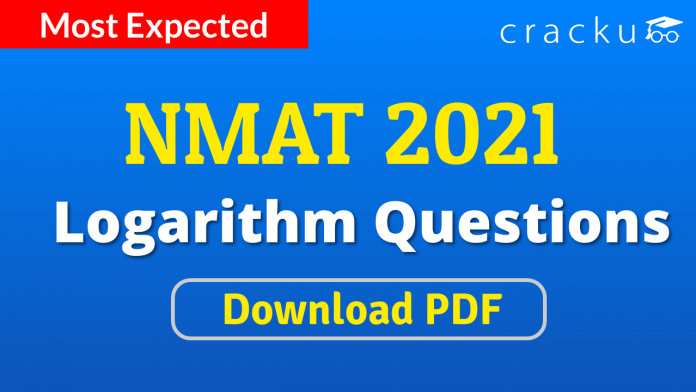Logarithm Questions for NMAT:
Download Logarithm Questions for NMAT PDF. Top 10 very important Logarithm Questions for NMAT based on asked questions in previous exam papers.
Download Logarithm Questions for NMAT
Take NMAT mock test
Question 1: Sham is trying to solve the expression:
$\log \tan 1^\circ + \log \tan 2^\circ + \log \tan 3^\circ + …….. + \log \tan 89^\circ$.
The correct answer would be?
a) 1
b) $\frac{1}{\sqrt{2}}$
c) 0
d) -1
Question 2: Find the value of $\log_{10}{10} + \log_{10}{10^2} + ….. + \log_{10}{10^n}$
a) $n^{2} + 1$
b) $n^{2} – 1$
c) $\frac{(n^{2} + n)}{2}.\frac{n(n + 1)}{3}$
d) $\frac{(n^{2} + n)}{2}$
Question 3: If $\log_{12}{81}=p$, then $3(\dfrac{4-p}{4+p})$ is equal to
a) $\log_{4}{16}$
b) $\log_{6}{16}$
c) $\log_{2}{8}$
d) $\log_{6}{8}$
Question 4: If $\log_{a}{30}=A,\log_{a}({\frac{5}{3}})=-B$ and $\log_2{a}=\frac{1}{3}$, then $\log_3{a}$ equals
a) $\frac{2}{A+B-3}$
b) $\frac{2}{A+B}-3$
c) $\frac{A+B}{2}-3$
d) $\frac{A+B-3}{2}$
Question 5: $(1+5)\log_{e}3+\frac{(1+5^{2})}{2!}(\log_{e}3)^{2}+\frac{(1+5^{3})}{3!}(\log_{e}3)^{3}+…$
a) 12
b) 244
c) 243
d) 245
Question 6: If $\log_{2}{x}.\log_{\frac{x}{64}}{2}=\log_{\frac{x}{16}}{2}$. Then x is
a) 2
b) 4
c) 16
d) 12
Question 7: Let $u = ({\log_2 x})^2 – 6 {\log_2 x} + 12$ where x is a real number. Then the equation $x^u = 256$, has
a) no solution for x
b) exactly one solution for x
c) exactly two distinct solutions for x
d) exactly three distinct solutions for x
Question 8: If $\log{3}, log(3^{x} – 2)$ and $log (3^{x}+ 4)$ are in arithmetic progression, then x is equal to
a) $\frac{8}{3}$
b) $\log_{3}{8}$
c) $\log_{2}{3}$
d) $8$
Question 9: If Y is a negative number such that $2^{Y^2({\log_{3}{5})}}=5^{\log_{2}{3}}$, then Y equals to:
a) $\log_{2}(\frac{1}{5})$
b) $\log_{2}(\frac{1}{3})$
c) $-\log_{2}(\frac{1}{5})$
d) $-\log_{2}(\frac{1}{3})$
Question 10: If x is a positive quantity such that $2^{x}=3^{\log_{5}{2}}$. then x is equal to
a) $\log_{5}{8}$
b) $1+\log_{3}({\frac{5}{3}})$
c) $\log_{5}{9}$
d) $1+\log_{5}({\frac{3}{5}})$
Join 7K MBA Aspirants Telegram Group
Download Highly Rated CAT preparation App
Answers & Solutions:
1) Answer (C)
$\log \tan 1^\circ + \log \tan 2^\circ + \log \tan 3^\circ + …….. + \log \tan 89^\circ$.
=$\log \tan 1^\circ + \log \tan 89^\circ + \log \tan 2^\circ + \log \tan 88^\circ …….. + \log \tan 45^\circ$.
=$\log\ \left(\tan\ 1^0\cdot\tan\ 89^0\right)\times\log\ \left(\tan\ 2^0\cdot\tan\ 88^0\right)\ ………………………\log\ \left(\tan\ 45^0\right)$
tan $45^0$ = 1
$\log\ \left(\tan\ 45^0\right)\ =\ 0$
$\therefore$ $\log \tan 1^\circ + \log \tan 2^\circ + \log \tan 3^\circ + …….. + \log \tan 89^\circ$ = 0
2) Answer (D)
$\log_{10}{10} + \log_{10}{10^2} + ….. + \log_{10}{10^n}$
Since $\log_aa\ $ = 1
$\log_{10}{10} + \log_{10}{10^2} + ….. + \log_{10}{10^n}$ = 1+2+….n
=$\ \frac{\ n\left(n+1\right)}{2}$
=$\frac{(n^{2} + n)}{2}$
D is the correct answer.
3) Answer (D)
Given that: $\log_{12}{81}=p$
$\Rightarrow$ $\log_{81}{12}=\dfrac{1}{p}$
$\Rightarrow$ $4\log_{3}{3*4}=\dfrac{1}{p}$
$\Rightarrow$ $1+\log_{3}{4}=\dfrac{4}{p}$
Using Componendo and Dividendo,
$\Rightarrow$ $\dfrac{1+\log_{3}{4}-1}{1+\log_{3}{4}+1}=\dfrac{4-p}{4+p}$
$\Rightarrow$ $\dfrac{\log_{3}{4}}{2+\log_{3}{4}}=\dfrac{4-p}{4+p}$
$\Rightarrow$ $\dfrac{\log_{3}{4}}{\log_{3}{9}+\log_{3}{4}}=\dfrac{4-p}{4+p}$
$\Rightarrow$ $\dfrac{\log_{3}{4}}{\log_{3}{36}}=\dfrac{4-p}{4+p}$
$\Rightarrow$ $3*\dfrac{4-p}{4+p}=\dfrac{3\log_{3}{4}}{\log_{3}{36}}$
$\Rightarrow$ $3*\dfrac{4-p}{4+p}=\dfrac{\log_{3}{64}}{\log_{3}{36}}$
$\Rightarrow$ $3*\dfrac{4-p}{4+p}=\log_{36}{64}$
$\Rightarrow$ $3*\dfrac{4-p}{4+p}=\log_{6^2}{8^2}=\log_{6}{8}$. Hence, option D is the correct answer.
4) Answer (A)
$\log_a30=A\ or\ \log_a5+\log_a2+\log_a3=A$………..(1)
$\log_a\left(\frac{5}{3}\right)=-B\ or\ \log_a3-\log_a5=B$………….(2)
and finally $\log_a2=3$
Substituting this in (1) we get $\log_a5+\log_a3=A-3$
Now we have two equations in two variables (1) and (2) . On solving we get
$\log_a3=\frac{\left(A+B-3\right)}{2\ }or\ \log_3a=\frac{2}{A+B-3}$
5) Answer (B)
Splitting the above mentioned series into two series
A = $\log_{e}3+\frac{1}{2!}(\log_{e}3)^{2}+\frac{1}{3!}(\log_{e}3)^{3}+…$
B = $5\log_{e}3+\frac{5^{2}}{2!}(\log_{e}3)^{2}+\frac{5^{3}}{3!}(\log_{e}3)^{3}+…$
We know that $e^{x}$ =$1+x+\frac{x^{2}}{2!}+\frac{x^{3}}{3!}+…$
So $e^{x}-1$ = $x+\frac{x^{2}}{2!}+\frac{x^{3}}{3!}+…$
On solving two series A and B
A = $\log_{e}3+\frac{1}{2!}(\log_{e}3)^{2}+\frac{1}{3!}(\log_{e}3)^{3}+…$ =$e^{\log_{e}3}-1$ = $3-1$ =$2$
B = $5\log_{e}3+\frac{5^{2}}{2!}(\log_{e}3)^{2}+\frac{5^{3}}{3!}(\log_{e}3)^{3}+…$=$e^{\log_{e}3^{5}}-1$=$3^{5}-1$=$242$
A+B = $2 + 242$ = $244$
6) Answer (B)
$\log_{2}{x}.\log_{\frac{x}{64}}{2}=\log_{\frac{x}{16}}{2}$
i.e. $\frac{log{x}}{log{2}} * \frac{log_{2}}{log{x}-log{64}} = \frac{log{2}}{log{x}-log{16}}$
i.e. $\frac{log{x} * (log{x}-log{16})}{log{x}-log{64}}$ = $\log{2}$
let t = log x
Therefore, $\frac{t * (t-log{16})}{t-log{64}}$ = $\log{2}$
$t^2-4*log 2*t = t*log 2-6*(log 2)^2$
I.e. $t^2-5*log 2*t-6*(log 2)^2$ = 0
I.e. $t^2-3*log 2*t-2*log 2*t-6*(log 2)^2$ = 0
i.e. $t*(t-3*log 2)-2*log 2*(t-3*log 2)$ = 0
i.e $t=2*log 2$ or $t=3*log 2$
i.e $log x=log 4$ or $log x=log 8$
therefore $x=4$ or $8$
therefore our answer is option ‘B’
7) Answer (B)
$x^u = 256$
Taking log to the base 2 on both the sides,
$u * \log_{2}{x} = \log_{2}{256}$
=>$[({\log_2 x})^2 – 6 {\log_2 x} + 12] * \log_{2}{x} = 8$
$(log_2 x)^3 – 6(log_2 x)^2 + 12log_2 x = 8$
Let $log_2 x = t$
$t^3 – 6t^2 +12t – 8 = 0$
$(t-2)^3 = 0$
Therefore, $log_2 x = 2$
=> $x = 4$ is the only solution
Hence, option B is the correct answer.
8) Answer (B)
If $log{3}, log(3^{x} – 2)$ and $log (3^{x}+ 4)$ are in arithmetic progression
Then, $2*log(3^{x} – 2) = log{3}+log (3^{x}+ 4)$
Thus, $log{(3^{x} – 2)^2} = log{3(3^x+4)}$
Thus, $(3^{x} – 2)^2 = 3(3^x+4)$
=> $3^{2x} – 4*3^x +4 = 3*3^x + 12$
=> $3^{2x} – 7*3^x – 8 = 0$
=> $(3^x+1)*(3^x-8) = 0$
But $3^x+1 \neq 0$
Thus, $3^x = 8$
Hence, $x = log_{3}{8}$
Hence, option B is the correct answer.
9) Answer (B)
$2^{Y^2({\log_{3}{5})}}=5^{Y^2(\log_3 2)}$
Given, $5^{Y^2\left(\log_32\right)}=5^{\left(\log_23\right)}$
=> $Y^2\left(\log_32\right)=\left(\log_23\right)=>Y^2=\left(\log_23\right)^2$
=>$Y=\left(-\log_23\right)^{\ }or\ \left(\log_23\right)$
since Y is a negative number, Y=$\left(-\log_23\right)=\left(\log_2\frac{1}{3}\right)$
10) Answer (D)
Givne that: $2^{x}=3^{\log_{5}{2}}$
$\Rightarrow$ $2^{x}=2^{\log_{5}{3}}$
$\Rightarrow$ $x=\log_{5}{3}$
$\Rightarrow$ $x=\log_{5}{\dfrac{3*5}{5}}$
$\Rightarrow$ $x=\log_{5}{5}+\log_{5}{\dfrac{3}{5}}$
$\Rightarrow$ $x=1+\log_{5}{\dfrac{3}{5}}$. Hence, option D is the correct answer.
We hope this Logarithm Questions for NMAT pdf for NMAT exam will be highly useful for your Preparation.





![CAT Averages Questions PDF [Important Questions] CAT AVERAGES Questions PDF](https://cracku.in/blog/wp-content/uploads/2022/07/CAT-AVERAGES-Questions-PDF-218x150.png)
